Tunguska Ufo Crash Explosion
INTRODUCTION
The Tunguska explosion occurred on the morning of June 30, 1908 at 7:17 A.M. local time (0h 17m 11s U.T.) in the area of the Stony Tunguska River with the coordinates of the epicenter being 60º55’ N, 101º57’ E (Kridec 1966).
At around 7:15 a.m., Tungus natives and Russian settlers in the hills northwest of Lake Baikal observed a column of bluish light, nearly as bright as the Sun, moving across the sky. About 10 minutes later, there was a flash and a loud "knocking" sound similar to artillery fire that went in short bursts spaced increasingly wider apart. Eyewitnesses closer to the explosion reported the sound source moving during each barrage, east to north. The sounds were accompanied by a shock wave that knocked people off their feet and broke windows hundreds of miles away. The majority of eyewitnesses reported only the sounds and the tremors, and not the sighting of the explosion. Eyewitness accounts differ as to the sequence of events and their overall duration.
The Tunguska explosion occurred on the morning of June 30, 1908 at 7:17 A.M. local time (0h 17m 11s U.T.) in the area of the Stony Tunguska River with the coordinates of the epicenter being 60º55’ N, 101º57’ E (Kridec 1966).
At around 7:15 a.m., Tungus natives and Russian settlers in the hills northwest of Lake Baikal observed a column of bluish light, nearly as bright as the Sun, moving across the sky. About 10 minutes later, there was a flash and a loud "knocking" sound similar to artillery fire that went in short bursts spaced increasingly wider apart. Eyewitnesses closer to the explosion reported the sound source moving during each barrage, east to north. The sounds were accompanied by a shock wave that knocked people off their feet and broke windows hundreds of miles away. The majority of eyewitnesses reported only the sounds and the tremors, and not the sighting of the explosion. Eyewitness accounts differ as to the sequence of events and their overall duration.
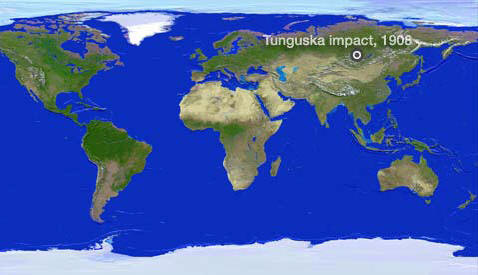
The location of the Tunguska impact: 101º57'E, 60º55'N
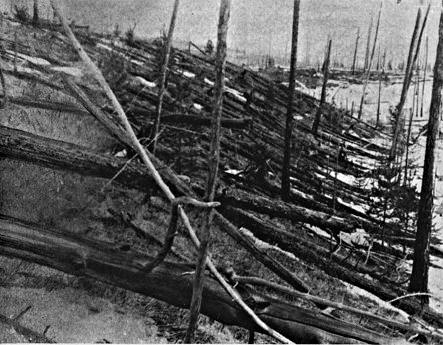
Trees felled by the Tunguska explosion. Credit: the Leonid Kulik Expedition. [SOURCE]
The explosion registered on seismic stations across Eurasia. Although the Richter scale was not developed until 1935, it has been estimated that in some places the shock wave would have been equivalent to an earthquake of 5.0 on the Richter scale. It also produced fluctuations in atmospheric pressure strong enough to be detected by then recently invented barographs in Britain. Over the next few weeks, night skies were aglow such that one could read in their light, sometimes called "bright nights." In the United States, the Smithsonian Astrophysical Observatory and the Mount Wilson Observatory observed a decrease in atmospheric transparency that lasted for several months.
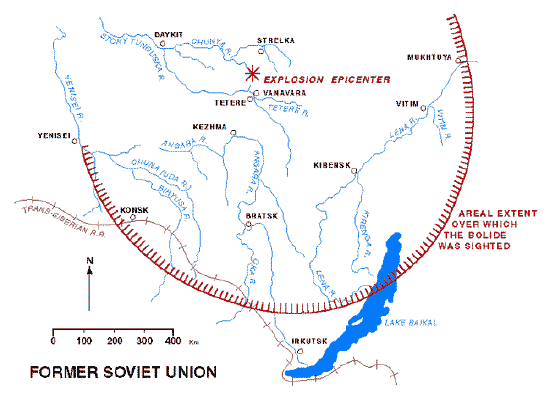
FIG 1. Area map of the 1908 Tunguska explosion event. After Sullivan 1979.
The Guinness Book of World Records (1966 edition) states that due to the rotation of the Earth, if the collision had occurred 4 hours 47 minutes later, it would have completely destroyed the city of St. Petersburg.
History
There was little scientific curiosity about the impact at the time, possibly owing to the isolation of the Tunguska region. If there were any early expeditions to the site, the records were lost during the subsequent chaotic years - World War I, the Russian Revolution of 1917, and the Russian Civil War.
The first recorded expedition arrived at the scene more than a decade after the event. In 1921, the Russian mineralogist Leonid Kulik, visiting the Podkamennaya Tunguska River basin as part of a survey for the Soviet Academy of Sciences, deduced from local accounts that the explosion had been caused by a giant meteorite impact. He persuaded the Soviet government to fund an expedition to the Tunguska region, based on the prospect of meteoritic iron that could be salvaged to aid Soviet industry. Kulik's party reached the site in 1927. To their surprise, no crater was to be found. There was instead a region of scorched trees about 50 kilometres (30 mi) across. A few near ground zero were still strangely standing upright, their branches and bark stripped off. Those farther away had been knocked down in a direction away from the center.
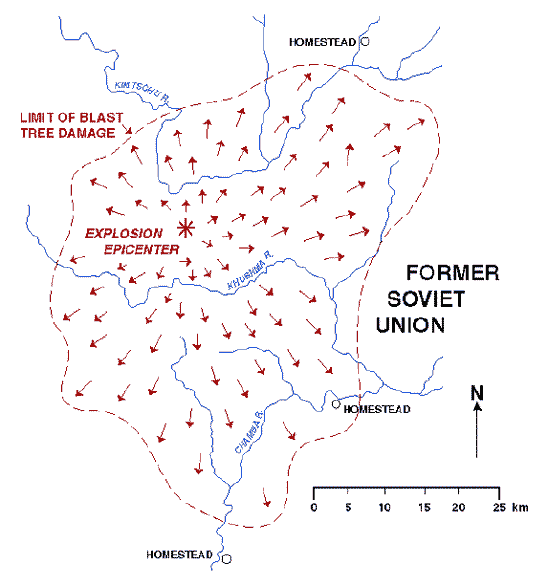
FIG 2. Map depicting fallen tree pattern (arrows represent direction) from explosion of 1908. This is a closeup of the impact site of Figure 1. After Sullivan 1979 and Kridec 1966.
Source: http://www.icr.org/research/index/researchp_sa_r05/
Source: http://www.icr.org/research/index/researchp_sa_r05/
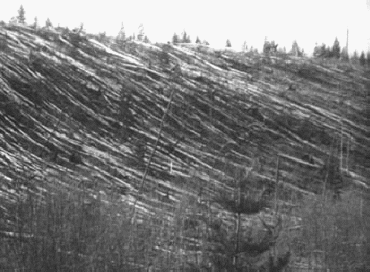
Trees near the Podkamennaya Tunguska River in Siberia still looked devastated nearly two decades after a large meteorite exploded above the ground in June 1908. The Tunguska event, which ranks as one of the most violent cosmic impacts of this century, leveled nearly 800 square miles of forested taiga. Smithsonian Institution.
Source: http://www.icr.org/research/index/researchp_sa_r05/
The curious effect of the Tunguska explosion on the trees near ground zero was replicated during atmospheric nuclear tests in the 1950s and 1960s. These effects are caused by the shock wave produced by large explosions. The trees directly below the explosion are stripped as the blast wave moves vertically downward, while trees further away are felled because the blast wave is travelling closer to the horizontal when it reaches them.
Soviet experiments performed in the mid-1960s, with model forests (made of matches) and small explosive charges slid downward on wires, produced butterfly-shaped blast patterns strikingly similar to the pattern found at the Tunguska site. The experiments suggested that the object had approached at an angle of roughly 30 degrees from the ground and 115 degrees from north and had exploded in mid-air.
During the next ten years there were three more expeditions to the area. Kulik found a little "pothole" bog that he thought might be the crater, but after a laborious exercise in draining the bog, he found there were old stumps on the bottom, ruling out the possibility that it was a crater. In 1938, Kulik managed to arrange for an aerial photographic survey of the area, which revealed that the event had knocked over trees in a huge butterfly-shaped pattern. Despite the large amount of devastation, there was no crater to be seen. Expeditions sent to the area in the 1950s and 1960s found microscopic glass spheres in siftings of the soil. Chemical analysis showed that the spheres contained high proportions of nickel and iridium, which are found in high concentrations in meteorites, hinting that they were of extraterrestrial origin.
Eyewitness Reports
Detailed systematic eyewitness reports began to be gathered as late as 1959, when interviews were conducted with many of the indigenous people who had been within 100 kilometres (60 mi) of the explosion. Most of these accounts claimed that the local people had been covered with boils after the explosion, with whole families dying off. The medical scientists attached to the expedition concluded that there had been an epidemic of smallpox in the area at the time. Expeditions led by Gennady Plekhanov found no elevated levels of radiation, which would have been expected had the detonation been nuclear in nature.
"At breakfast time I was sitting by the house at Vanavara trading post (65 kilometres/40 miles south of the explosion), facing North. [...] I suddenly saw that directly to the North, over Onkoul's Tunguska road, the sky split in two and fire appeared high and wide over the forest (as Semenov showed, about 50 degrees up - expedition note). The split in the sky grew larger, and the entire Northern side was covered with fire. At that moment I became so hot that I couldn't bear it, as if my shirt was on fire; from the northern side, where the fire was, came strong heat. I wanted to tear off my shirt and throw it down, but then the sky shut closed, and a strong thump sounded, and I was thrown a few yards. I lost my senses for a moment, but then my wife ran out and led me to the house. After that such noise came, as if rocks were falling or cannons were firing, the earth shook, and when I was on the ground, I pressed my head down, fearing rocks would smash it. When the sky opened up, hot wind raced between the houses, like from cannons, which left traces in the ground like pathways, and it damaged some crops. Later we saw that many windows were shattered, and in the barn a part of the iron lock snapped."
-- Testimony of S. Semenov, as recorded by Leonid Kulik's expedition in 1930.
"We had a hut by the river with my brother Chekaren. We were sleeping. Suddenly we both woke up at the same time. Somebody shoved us. We heard whistling and felt strong wind. Chekaren said, 'Can you hear all those birds flying overhead?' We were both in the hut, couldn't see what was going on outside. Suddenly, I got shoved again, this time so hard I fell into the fire. I got scared. Chekaren got scared too. We started crying out for father, mother, brother, but no one answered. There was noise beyond the hut, we could hear trees falling down. Me and Chekaren got out of our sleeping bags and wanted to run out, but then the thunder struck. This was the first thunder. The Earth began to move and rock, wind hit our hut and knocked it over. My body was pushed down by sticks, but my head was in the clear. Then I saw a wonder: trees were falling, the branches were on fire, it became mighty bright, how can I say this, as if there was a second sun, my eyes were hurting, I even closed them. It was like what the Russians call lightning. And immediately there was a loud thunderclap. This was the second thunder. The morning was sunny, there were no clouds, our Sun was shining brightly as usual, and suddenly there came a second one!
"Me and Chekaren had some difficulty getting under from the remains of our hut. Then we saw that above, but in a different place, there was another flash, and loud thunder came. This was the third thunder strike. Wind came again, knocked us off our feet, struck against the fallen trees. "We looked at the fallen trees, watched the tree tops get snapped off, watched the fires. Suddenly Chekaren yelled 'Look up' and pointed with his hand. I looked there and saw another flash, and it made another thunder. But the noise was less than before. This was the fourth strike, like normal thunder. "Now I remember well there was also one more thunder strike, but it was small, and somewhere far away, where the Sun goes to sleep."
-- Testimony of Chuchan of Shanyagir tribe, as recorded by I.M.Suslov in 1926.
"On the 17th of June, around 9 in the AM, we observed an unusual natural occurrence. In the N Karelinski village (200 verst N of Kirensk) the peasants saw to the North-West, rather high above the horizon, some strangely bright (impossible to look at) bluish-white heavenly body, which for 10 minutes moved downwards. The body appeared as a "pipe", i.e. a cylinder. The sky was cloudless, only a small dark cloud was observed in the general direction of the bright body. It was hot and dry. As the body neared the ground (forest), the bright body seemed to smudge, and then turned into a giant billow of black smoke, and a loud knocking (not thunder) was heard, as if large stones were falling, or artillery was fired. All buildings shook. At the same time the cloud began emitting flames of uncertain shapes. All villagers were stricken with panic and took to the streets, women cried, thinking it was the end of the world. "The author of these lines was meantime in the forest about 6 verst N of Kirensk, and heard to the NE some kind of artillery barrage, that repeated in intervals of 15 minutes at least 10 times. In Kirensk in a few buildings in the walls facing north-east window glass shook."
-- Sibir newspaper, July 2, 1908
"When the meteorite fell, strong tremors in the ground were observed, and near the Lovat village of the Kansk uezd two strong explosions were heard, as if from large-caliber artillery."
-- Siberian Life newspaper, July 27, 1908
"Kezhemskoe village. On the 17th an unusual atmospheric event was observed. At 7:43 the noise akin to a strong wind was heard. Immediately afterwards a horrific thump sounded, followed by an earthquake which literally shook the buildings, as if they were hit by a large log or a heavy rock. The first thump was followed by a second, and then a third. Then - the interval between the first and the third thumps were accompanied by an unusual underground rattle, similar to a railway upon which dozens of trains are traveling at the same time. Afterwards for 5 to 6 minutes an exact likeness of artillery fire was heard: 50 to 60 salvoes in short, equal intervals, which got progressively weaker. After 1.5 - 2 minutes after one of the "barrages" six more thumps were heard, like cannon firing, but individual, loud, and accompanied by tremors. "The sky, at the first sight, appeared to be clear. There was no wind and no clouds. However upon closer inspection to the North, i.e. where most of the thumps were heard, a kind of an ashen cloud was seen near the horizon which kept getting smaller and more transparent, and possibly by around 2-3 p.m. completely disappeared."
-- Krasnoyaretz newspaper, July 13, 1908
Blast Patterns
Below is our interpretation of satellite Images (Google Earth) of the Impact area.
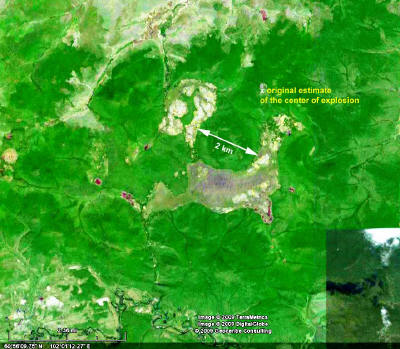
Tunguska the epicenter area: 60º55’ N, 101º57’ E
Google Earth image
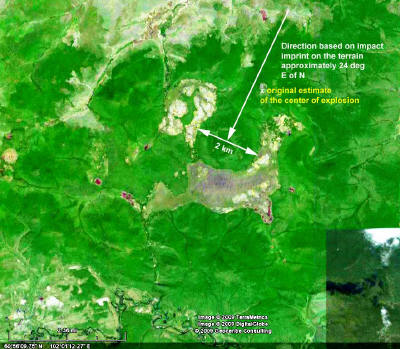
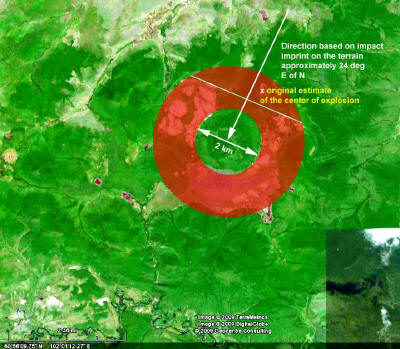
Tunguska Explosion Theories
There were many theories proposed to explain Tunguska event ( exploding UFO, Black Hole, Antimatter, natural H-bomb), but the generally agreed upon theory is that on the morning of June 30, 1908, a large space rock, about 120 feet across, entered the atmosphere of Siberia and then detonated in the sky."
It is estimated the asteroid entered Earth's atmosphere traveling at a speed of about 33,500 miles per hour. During its quick plunge, the 220-million-pound space rock heated the air surrounding it to 44,500 degrees Fahrenheit. At 7:17 a.m. (local Siberia time), at a height of about 28,000 feet, the combination of pressure and heat caused the asteroid to fragment and annihilate itself, producing a fireball and releasing energy equivalent to about 185 Hiroshima bombs.
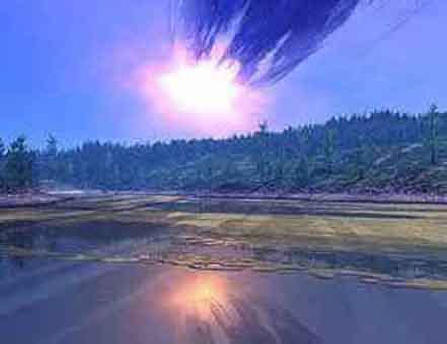
Another estimate is that the explosion was most likely caused by the airburst of a large (around 20 m (66 ft) across) meteoroid or comet fragment at an altitude of 5 to 10 kilometers (3-6 mi) above the Earth's surface. Although the meteor or comet is considered to have burst prior to hitting the surface, this event is still referred to as an impact event. The energy of the blast was estimated to be between 10 and 20 megatons of TNT, 1,000 times more powerful than the bomb dropped on Hiroshima, or equivalent to Castle Bravo, the most powerful nuclear bomb ever detonated by the US.
The Tunguska explosion felled an estimated 80 million trees over 2,150 square kilometers (830 sq mi). An overhead satellite view, from nearly a century later, centered at 101º57'E, 60º55'N (near ground zero for this event) shows an area of reduced forest density with a clearly visible, irregular clearing of somewhat less than one square kilometer in area. It is estimated to have measured 5.0 on the Richter scale.
The Tunguska event is the largest impact event in recent history. An explosion of this magnitude had the potential to devastate large metropolitan areas should it occur over a large city. This has helped spark discussion of ways to potentially stop large asteroids or comets from hitting Earth.
Asteroid or Comet?
The composition of the Tunguska body remains a matter of controversy.
In 1930, the British astronomer F.J.W. Whipple suggested that the Tunguska body was a small comet. A cometary meteorite, being composed primarily of ice and dust, could have been completely vaporized by the impact with the Earth's atmosphere, leaving no obvious traces. The comet hypothesis was further supported by the glowing skies (or "skyglows" or "bright nights") observed across Europe for several evenings after the impact, apparently caused by dust that had been dispersed across the upper atmosphere.
In 1978, Slovak astronomer Lubor Kresak suggested that the body was a piece of the short-period Comet Encke, which is responsible for the Beta Taurid meteor shower; the Tunguska event coincided with a peak in that shower. It is now known that bodies of this kind explode at frequent intervals tens to hundreds of kilometres above the ground. Military satellites have been observing these explosions for decades.
In 1983, astronomer Zdenek Sekanina published a paper criticizing the comet hypothesis. He pointed out that a body composed of cometary material, travelling through the atmosphere along such a shallow trajectory, ought to have disintegrated, whereas the Tunguska body apparently remained intact into the lower atmosphere. Sekanina argued that the evidence pointed to a dense, rocky object, probably of asteroidal origin.
This hypothesis was further boosted in 2001, when Farinella, Foschini, et al. released a study suggesting that the object had arrived from the direction of the asteroid belt.
Proponents of the comet hypothesis have suggested that the object was an extinct comet with a stony mantle that allowed it to penetrate the atmosphere.
The chief difficulty in the asteroid hypothesis is that a stony object should have produced a large crater where it struck the ground, but no such crater has been found. It has been hypothesized that the passage of the asteroid through the atmosphere caused pressures and temperatures to build up to a point where the asteroid abruptly disintegrated in a huge explosion. The destruction would have to have been so complete that no remnants of substantial size survived, and the material scattered into the upper atmosphere during the explosion would have caused the skyglows.
Models published in 1993 suggested that the stony body would have been about 60 metres across, with physical properties somewhere between an ordinary chondrite and a carbonaceous chondrite.
Christopher Chyba and others have proposed a process whereby a stony meteorite could have exhibited the behavior of the Tunguska impactor. Their models show that when the forces opposing a body's descent become greater than the cohesive force holding it together, it blows apart, releasing nearly all its energy at once. The result is no crater, and damage distributed over a fairly wide radius, all of the damage being blast and thermal.
High levels of carbon that doesn't form on Earth found in peat bogs suggest a comet, which have high amounts of carbon compared to most asteroids, was the cause of the Tunguska event; however, it is not impossible for asteroids to contain the carbon necessary to result in the heightened levels of carbon in the peat bogs in 1908.
During the 1990s, Italian researchers extracted resin from the core of the trees in the area of impact, to examine trapped particles that were present during the 1908 event. They found high levels material commonly found in rocky asteroids and rarely found in comets.
Today, most Russian scientists believe the Tunguska event was the result of a comet, while most American scientists take the belief that it was some sort of asteroid.
Conclusion
The Tunguska explosion is indeed unique and mysterious. Of the possible causes it appears that the present consensus favors the comet hypothesis. However, suggesting a consensus is quite tenuous. Though the other theories have plausibility, they have difficulty explaining the observed event and the resulting physical evidence.
Making use of the cometary hypothesis allows for the following probable scenario.
Above central Siberia on June 30, 1908, at approximately 7:17 AM local time, a small comet entered the atmosphere from behind the sun and moved in a southeast to northwest direction. The comet was composed of about 30,000 tons of water, methane, and ammonia ice with traces of silicates and iron oxides. Penetrating the atmosphere at approximately 60 km/sec (130,000 mph), the object created an intense shock wave which wrapped tightly around its nose. As it descended that sunny morning, its nucleus exploded (possibly 3 times) approximately 8 km above the Earth’s surface.
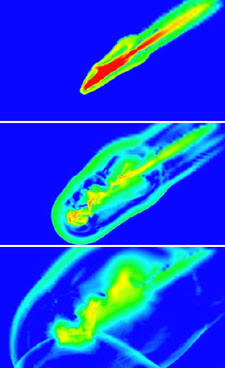
These three frames are from a computer simulation of the 1908 Tunguska event.
An impactor with 5 megatons of kinetic energy disintegrates and explodes 8 miles up,
sending a supersonic blast wave downward to the ground.
M. Boslough & D. Crawford / Sandia National Laboratories.
Source: http://www.skyandtelescope.com/community/skyblog/newsblog/12662606.html
A huge black cloud immediately appeared following the explosion which released 1023 ergs of energy. A heat wave with a temperature of approximately 16.6 million degrees Celsius at the focus was generated that had a tree-scorching effect for a radius of 15 km. The heat wave was followed by air shock waves which disfigured or toppled 80 million trees occupying approximately 8000 km2 of Siberian taiga (a radius of 30 km), and initiated a seismic wave of Richter magnitude 5, but, to our astonishment, left no crater.
The dust from the tail of the comet moved away from the sun and provided anomalously bright night sky in Europe and parts of Western Russia. No trace of the comet itself was found except for tiny magnetite and silicate globules. The principal consequences were fear and awe among the inhabitants of the region, and the physical damage from the explosion. Fortunately, no human life was lost, though more than a thousand reindeer were destroyed.
Speculation will continue as to the origin of this catastrophe, yet no certain conclusions can be attained unless man has the dubious opportunity to observe and monitor such an event in the future.
The Tunguska explosion directs our attention to catastrophic forces which have helped form the earth, and causes us to ask questions about the nature of much larger cosmic events.
What were the global effects of enormous impact events which formed the 1-km-diameter Meteor Crater in Arizona (left image), the 100-km-diameter Popigay crater of Siberia, and the 140-km-diameter Sudbury impact structure of Ontario? What changes in the earth’s crust, atmosphere, ocean and life were caused by the release of a million times more energy than the Tunguska explosion?
************************************************
The Tunguska event provides a faint glimpse.
Subject Related Links and Resources
http://www.skyandtelescope.com/community/skyblog/newsblog/12662606.html
http://www.bibliotecapleyades.net/ciencia/esp_ciencia_tunguska01.htm
http://www.crystalinks.com/tunguskaevent.html
http://science.nasa.gov/headlines/y2008/30jun_tunguska.htm
Tunguska Event Wikipedia
http://www.lpi.usra.edu/meetings/LPSC99/pdf/1186.pdf
http://thunderbolts.info/tpod/00subjectx.htm
http://thunderbolts.info/tpod/2006/arch06/060202tunguska.htm
http://thunderbolts.info/tpod/2006/arch06/060203tunguska2.htm
http://thunderbolts.info/tpod/2007/arch07/070705newcrater.htm
Tunguska Event UFO Crash Wikipedia
Researchers say Tunguska Event was a UFO Crash: Debris of Alien Spaceship found
PhysOrg - August 10, 2004
The Tunguska Event - Siberia, 1908 UFO Evidence - Various Articles
Tunguska event could be a UFO crash Pravda - September 22, 2006
References
Astapowitsch, I.S. 1934. Air waves caused by the fall of the meteorite on 30th June, 1908, in Central Siberia. Royal Meteorological Society Quarterly Journal 60:493-504.
Beasley, W.H. and Tinsley, B.A. 1974. Tungus event was not caused by a black hole. Nature 250:555-556.
Ben-Menahem, Ari. 1975. Source parameters of the Siberia explosion of June 30, 1908, from analysis and synthesis of seismic signals at four stations. Physics of the Earth and Planetary Interiors 11:1-35.
Brown, J.C. and Hughes, D.W. 1977. Tunguska’s Comet and non-thermal C14 production in the atmosphere. Nature 268:512-514.
Cowan, C., Alturi, C.R., and Libby, W.F. 1965. Possible anti-matter content of the Tunguska meteor of 1908. Nature 206:861-865.
Fesenkov, V.G. 1962. On the cometary nature of the Tunguska meteorite.
Soviet Astronomy 5(4):441-451.
Fesenkov, V.G. 1966. A study of the Tunguska meteorite fall. Soviet Astronomy 10(2):195-213.
Gentry, R.V. 1966. Anti-matter content of the Tunguska meteor. Nature 211:1071-1072.
Hughes, D.W. 1976. Tunguska revisited. Nature 259:626-627.
Jackson, A.A. and Ryan, M.P. 1973. Was the Tungus event due to a black hole?
Nature 245:88-89.
Kridec, E.L. 1960. Principles of meteorites. Pergamon Press, Oxford.
Kridec, E.L. 1963. The Tunguska and Sikhote-Alin meteorites. In B. Middlehurst and G.P. Kuiper, eds. The Solar System, Vol. IV: Moon, Meteorites and Comets, pp. 208-217.
University of Chicago Press, Chicago.
Kridec, E.L. 1966. Giant meteorites. Pergamon Press, Oxford.
LeMaire, T.R. 1980. Stones from the stars. Prentice Hall, Englewood Cliffs, New Jersey.
Lerman, J.C., Mook, W.G., and Vogel, J.C. 1967. Effect of the Tunguska Meteor and sunspots on radiocarbon in tree rings. Nature 216:990-991.
McWhirter, N. and McWhirter, R. 1974.
Guinness book of world records, 1975. Sterling, New York.
Stanyukovich, K.P. and Bronshten, I.A. 1961. Velocity and energy of the Tunguska meteorite. Doklady Akademii Nauk SSSR, earth sciences sections 140:1053-1055.
Sullivan, W. 1979. Black holes, the edge of space, the end of time.
Doubleday, Garden City, New York.
Thorndike, J.J., Jr., ed. 1977. Mysteries of the past.
American Heritage Publishing Company, New York.
Whipple, F.J.W. 1930. The great Siberian meteor and the waves, seismic and aerial, which it produced. Royal Meteorological Society Quarterly Journal 56:287-304.
Whipple, F.J.W. 1934. On phenomena related to the great Siberian meteor.
Royal Meteorological Society Quarterly Journal 60:505-513.
Whipple, F.W. 1950. A comet model I. The acceleration of the Comet Encke.
Astrophysical Journal 111(1):375-379.
Whipple, F.W. 1975. Do comets play a role in galactic chemistry and gamma-ray bursts?
The Astronomical Journal 80(7):525-531.

